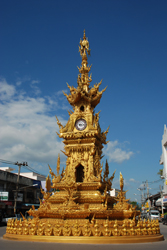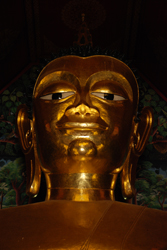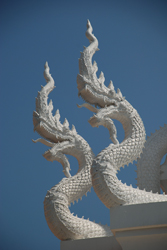Chiang Rai and the Hill Tribe Museum
12 April, 2009, 03:29 am in "Thailand"
Chiang Rai is a city-- large and busy compared to everywhere in Laos-- and very modern (though probably not when compared to places besides Laos.) It is refreshing to be in a city of a reasonable size without many tourists and where there are other sources of income besides tourism.
The Hill Tribe Museum is part of a center run by the PDA (Population and Community Development Association). After we bought our tickets we were ushered into a room and shown what turned out to be an interesting film about community based tourism called, "So Human a Zoo". It focused on a couple (Burmese and French I think) who were investigating opening an eco-lodge in Patau, in the North of Burma and their trip to villages (some which had never had foreigners visit) to discuss how they could involve the villagers and contribute to their community.
It addressed many of the problems with tourism I've been noticing. i.e. the economic development and outside influences brought by tourism eventually caused the community to lose their traditional culture which then brings about the demise of tourism (which in turn brings about the demise of their financial source). As one person in the film said, "Having satellite TV might be more important than retaining a traditional way of life."
The film (and information in the museum) also addressed the exploitation of "long necked" Karen people in Thailand. The long necked Karen people are actually from Burma. The Thai Karen do not wear neck rings. However, Thai entrepreneurs have created long neck Karen villages and brought Karen people from Burma or refugee camps to populate them. These Karen, the women only , are paid about 1000 baht a month (about $30) to "live" in the village and wear neck rings. They are often not allowed to get Thai ID cards so are trapped in the villages (to travel to anywhere else requires an ID). Tourists are charged a lot of money to visit the "villages" but the village owner is the only one to benefit. The film mentioned a true CBT project--the only one in the Chiang Rai region that provides direct benefits to the village-- called Ban Lorcha.
The museum had a lot of info about opium (we are near the Golden Triangle) and several individual sections on each of the tribe's architecture, traditions, tools, etc. The last room had displays on traditional culture.
It addressed many of the problems with tourism I've been noticing. i.e. the economic development and outside influences brought by tourism eventually caused the community to lose their traditional culture which then brings about the demise of tourism (which in turn brings about the demise of their financial source). As one person in the film said, "Having satellite TV might be more important than retaining a traditional way of life."
The film (and information in the museum) also addressed the exploitation of "long necked" Karen people in Thailand. The long necked Karen people are actually from Burma. The Thai Karen do not wear neck rings. However, Thai entrepreneurs have created long neck Karen villages and brought Karen people from Burma or refugee camps to populate them. These Karen, the women only , are paid about 1000 baht a month (about $30) to "live" in the village and wear neck rings. They are often not allowed to get Thai ID cards so are trapped in the villages (to travel to anywhere else requires an ID). Tourists are charged a lot of money to visit the "villages" but the village owner is the only one to benefit. The film mentioned a true CBT project--the only one in the Chiang Rai region that provides direct benefits to the village-- called Ban Lorcha.
The museum had a lot of info about opium (we are near the Golden Triangle) and several individual sections on each of the tribe's architecture, traditions, tools, etc. The last room had displays on traditional culture.
Comments
- Comments
Powered by My Blog 1.69. Copyright 2003-2006 FuzzyMonkey.net.
Created by the scripting wizards at FuzzyMonkey.net..
(Code modified by Rowshan Dowlatabadi)
Created by the scripting wizards at FuzzyMonkey.net..
(Code modified by Rowshan Dowlatabadi)




